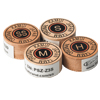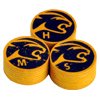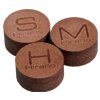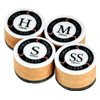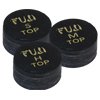
It is widely known that most of the performance of a pool cue lies in the shaft and the first six inches are especially important. At the very end of this most important area is the pool cue tip. This is where “the rubber hits the road” so to speak. The pool cue tip is where the energy from your pool cue is transferred to the cue ball (with a little help from chalk) to create the desired results of accuracy, speed and spin. Because of how much effect a tip can have on your game, it is important to choose the right one.
At PoolDawg.com, we offer one of the widest selections of pool cue tips with over 25 different brands featuring multiple styles and hardness options. Feeling overwhelmed? Fear not, we are here to help!
Tip Density and Hardness
The main characteristics to look at when choosing a pool cue tip is density and hardness. Tips vary in hardness from “super soft” to being as hard as the cue ball itself (phenolic). The hardness of the pool cue tip that you choose will depend on your style of play and whether it is for a playing cue or a breaking pool cue. To see the full list of tips and their specific density check out our pool cue tip density chart.

Soft tips will absorb more impact causing the tip to stay on the cue ball for a split second longer than harder tips. This will result in more cue ball spin, commonly referred to as “English”, when struck off the center of the cue ball. Softer tips tend to get misshaped faster and will require more maintenance to keep a nice rounded shape and to fix any mushrooming when the tip bulges out over the side of the ferrule. Because of the additional maintenance, softer tips end up needing to be replaced more frequently.
If you really like working the cue ball around the table and do not mind regularly shaping and trimming your tip, here are some popular soft tip choices:
Hard tips do not absorb or stay on the cue ball as much at impact as a softer tip would. Because of this, hard tips create less spin and are more liable to miscue when striking the cue ball farther off the center point. They will play more consistently, last longer and require less maintenance.
If you value the most consistency and do not want to mess around with making sure your tip is always well maintained, here are some great harder tips to try:
Medium tips are usually the way to go for most pool players because they offer a combination of cue ball control and consistency. Most medium tips will get you plenty of spin but do not get as misshaped or wear out as fast as the softer tips. The vast majority of pool cue manufacturers will install some form of a medium hardness tip on the cue as the standard tip. For example, Predator, Lucasi Custom, McDermott, 5280, Poison and Viking all come standard with medium layered leather tips that are essentially a Tiger Everest.
If you want an all around tip that keeps its shape and plays consistently with less maintenance try some of these medium tips
Phenolic Tips (or Carbon Fiber) are now standard issue on most breaking cues and they are REALLY hard tips. Break shots are usually struck close to the center of the cue ball so Phenolic tips, which are just as hard as the balls themselves, can still put a smooth, solid hit on the cue ball without miss-cueing. Phenolic tips are very popular because they transfer the most power and require almost no maintenance.
NOTE: Some Pool Halls, Leagues or Tournaments do not allow Non-Leather (phenolic) tips so make sure to check if you think it could be an issue.

Here are some of the best tips for breaking cues:
...and remember, folks, if you have any questions about these tips or anything we carry, please give us a call at 1-866-843-3294!

